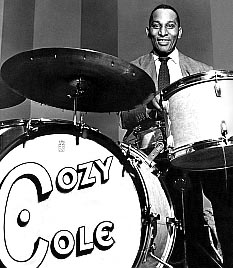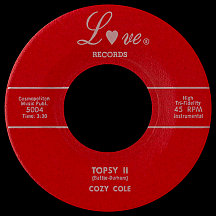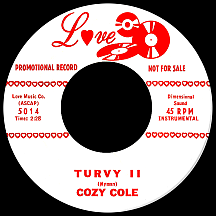COZY COLE
Topsy II
One of 1958's least predictable hits supported the notion that the big band music of the 1930s still had some life in its aging bones. 49-year-old drummer William Randolph "Cozy" Cole had been ruthlessly hammering the skins the previous three decades, rubbing elbows with a mind-bending assemblage of legendary jazz acts. "Topsy," an instrumental composed by Edgar Battle and Eddie Durham, had been recorded in 1938 by Count Basie and was a hit for Benny Goodman the same year. Cole's rock era remake was divided into two parts, each prefaced by his scratchy-voiced title intro; both were top 40 hits in the latter months of the year on the independent Love record label, but part "II," featuring a prominent drum solo, was the smash side, pulling off a six week run at the top of the R&B charts while reaching number three on the Billboard pop survey and number one on Cash Box. Cozy's fame was arguably more widespread than during his jazz band peak as a youthful skin-smasher. A can of worms had been opened. Everything turned topsy-turvy...at least the music did.
Cole grew up in East Orange, New Jersey and later attended school in Leonardo on Sandy Hook Bay. His entire family was musically inclined (two brothers and a sister were pianists) and Cozy learned to play drums in high school, banging his sticks on anything hard, leaving marks all over the furniture in his house. As a teenager during the 1920s, he became obsessed with drummer Sonny Green, an impressive showman from nearby Long Branch (who bludgeoned those canisters, threw his sticks in the air...and was so smooth doing it!), and vowed to work hard at sharpening his own skills. His nickname came courtesy of the other kids in school who, instead of calling him William, latched onto "Colesy," which, with casual use, sounded like "Cozy." The family moved to New York in 1926 and within two years he'd landed a spot with clarinetist Wilbur Sweatman's band (Greer had already played with the same outfit).
Jazz great Jelly Roll Morton had established himself years earlier in his native New Orleans before hopping around North America and finally setting up his Red Hot Peppers in N.Y. around '28. Cole joined the band in 1930; his most notable drum solo was on Jelly Roll's "Load of Coal." Greer had hit it big with Duke Ellington's band by this time, an achievement not lost on rabid fan Cole, who thumped the cylinders for more than a dozen bands big and small over the next decade; he was one of Blanche Calloway 's Joy Boys starting in 1930 and later played with brass man Benny Carter's group, followed by a mid-decade stint with Willie "Mayor of Harlem" Bryant. In 1939 he connected with Blanche's superstar brother Cab Calloway and spent the next few years as the Hi-De-Ho Man's percussionist, showing off his skills on recordings of "Ratamacue," "Paradiddle" and "Crescendo in Drums."
Landing on Broadway in 1943, he supplied the beat behind singer June Hawkins on "Beat Out Dat Rhythm on a Drum" from the musical Carmen Jones. In '44 he had a top ten hit on Billboard's "Harlem Hit Parade" chart; "Just One More Chance," on the Keynote label, was credited to Cozy Cole's All Stars, which included piano pro Earl Hines and two of Jelly Roll's former Peppers, Coleman Hawkins on tenor sax and Joe Thomas on trombone. Cozy made more records for the Keynote, Guild and Continental labels and backed Goodman, Charlie Parker, Dizzy Gillespie, Ella Fitzgerald and Satchmo in the studio. His frenetic mallet-pounding was evident during a stint with Louis Armstrong's All Stars from '49 to '53. With Gene Krupa, probably the only showbiz drummer with a higher profile, he founded the Krupa and Cole Drum School in New York City, keeping it rolling from 1954 until Krupa passed away in October 1973.

An appearance alongside Armstrong and Hines in the 1950 Italian film I'm in the Revue led to more movie moments behind the drumkit; The Strip, from '51, showcased a dozen jazz performances (Armstrong again) and a memorable moment in 1954's The Glenn Miller Story found him in a drumming duel with pal Krupa. A 1957 European tour with Hines and Jack Teagarden preceded his "comeback"...as if he hadn't been clearly visible the whole time! The amazing late-'58 popularity of "Topsy II" (and its lesser-impact topside) made way for "Turvy II" (penned by pianist Dick Hyman), spoken intro reprised, a top 40 hit near the end of the year (the more drum-heavy second side again making a stronger impact). "Caravan," an already classic 20-year-old tune written by Ellington and his trombonist, Juan Tizol, skipped the Cozy intro, going straight into action (canister-clubbing included), making a momentary chart appearance on the Felsted label in what could be considered C.C.'s career-peak month: November 1958. His success paved the way for other, younger-skewing percussion acts: Preston Epps went ballistic on a set of bongos with his spring '59 hit "Bongo Rock" and Sandy Nelson ignited a string of bucket-banging hits that fall with "Teen Beat."
Afterwards it was an embarrassment of gimmickry, one attempt after another by Cole to repeat the pattern set by his hits. Love Records' third offering, "(Everything Is) Topsy-Turvy," wasn't the last of its kind. A string of releases on King included two-sider "Blop-Up" and "Blop-Down," "'D' Natural Rock," a more slammin' take on Tiny Bradshaw's "Soft" and an original, "Cozy's Mambo"...all strong, musically precise performances. Singles popped up on offbeat labels between 1960 and '64 (and on a major one, Columbia, in '66), milking the egocentric concept with "Ala Topsy"...parts three and four...as well as "Play Cozy Play," "Cozy's Groove," "Cozy and Bossa" (as in Nova) and "A Cozy Beat." If I had copies of everything, I'd run them together into one big Cozy-Fest mix. A terrific remake on Coral of "Big Noise From Winnetka" (in two parts, of course, with a spoken title), first unleashed in the 1941 RKO film Let's Make Music, gave him his final (minor) chart record in January 1963.
Cozy toured Africa around this time as one exciting development followed another. Participating in the 1973 Newport Jazz Festival, he performed side-by-side with the jazz elite and slammed his sticks against the skins with trumpeter Jonah Jones's band for much of that decade. Cozy Cole died in January 1981; prior to his passing, one rock drummer paid tribute to the star in the best way possible. Colin Trevor Powell, the replacement for Carl Palmer of '70s band Emerson, Lake and Palmer (necessitating a name change to Emerson, Lake and Powell), adopted the professional name Cozy Powell in honor of the great musician who most influenced him.



